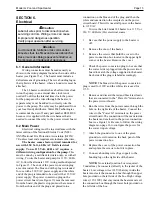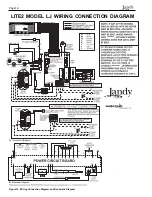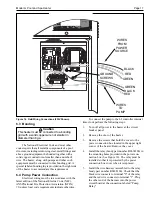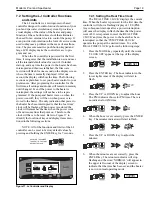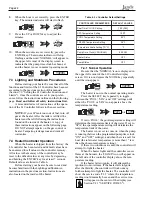
Page 28
Figure 21. Heater drain locations.
Water Pik Technologies, Inc. does not warrant
heat exchangers damaged by corrosive chemical
levels or excess dissolved solids in pool or spa
water.
For spas, it is also necessary to perform water
changes in addition to chemical treatment. It is recom-
mended to change the spa water every 60 days for
light usage and every 30 days if usage is heavy.
8.2 Seasonal Care
Caution
Do not operate this heater outdoors at
temperatures below 20 degrees Fahrenheit (°F)
(-7 degrees Celsius [°C]).
8.2.1 Spring and Fall Operation
During periods when the pool is only going to be
used occasionally, set the pool and spa control tem-
peratures to 70°F (21°C) (see Section 7.2.3). This
prevents the pool from water from becoming chilled,
and minimizes the time required to raise the pool water
back up to the desired temperature.
In areas subject to only short freeze periods, turn
off the heater. The Freeze control function of the
heater will start the pump when the water temperature
falls to the 'FREEZE SET' temperature (see Section
7.2.4). The pump will run continuously until the water
temperature has risen to 2° above the 'FREEZE SET'
temperature.
If the heater is not going to be used for a long
period of time, shut it down completely. Follow the
instructions found on the inside of the heater, or page
23 of this manual.
8.2.2 Winterizing
In areas where freezing temperatures occur in
winter, and the pool or spa will not be used, have your
service technician perform the following steps:
1.
Turn off the main gas supply valve to the heater,
outside the heater jacket.
2.
Remove heater door.
3.
Shut down the heater following the shutdown
instructions found on the inside of the heater.
4.
Remove the drain plug from the return header
(see Figure 21), loosen the drain plug from the
inlet/outlet header, and completely drain the
heater before the first frost.
5.
After all water has drained from the heater,
remove the drain plug from the inlet/outlet side.
Check for mineral buildup in the openings.
6.
Use compressed air to blow out any standing
water remaining in the heat exchanger.
7.
Grease the threads on the drain plugs and
reinstall plugs, but do not tighten.
8.
Disconnect the pressure switch from the siphon
loop (copper tubing) (see Figure 22).
Table 8. Mineral Concentration Levels
Test
Recommended Level
Free chlorine
1.0 to 3.0 ppm
Bromine
3.0 to 5.0 ppm
pH
7.2 to 7.8
Total alkalinity (TA)
80 to 120 ppm
Calcium hardness (CH)
200 to 400 ppm
Langelier saturation index (LSI) -0.5 to +0.5
Total dissolved solids (TDS)
Less than 2000 ppm
Cyanuric acid
30 to 150 ppm
Copper
0 ppm


